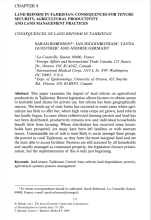Land Library Search
Through our robust search engine, you can search for any item of the over 73,000 highly curated resources in the Land Library.
If you would like to find an overview of what is possible, feel free to peruse the Search Guide.
/ library resources
Showing items 1 through 9 of 37.This paper examines the impact of land reform on agricultural productivity in Tajikistan. Recent legislation allows farmers to obtain access to heritable land shares for private use, but reform has been geographically uneven.
RECOFTC and RRI co-organized the International Conference on Poverty Reduction and Forests: Tenure, Market, and Policy Reforms, which was held 3-7 September 2007 in Bangkok.
This book examines the gender dimensions of natural resource exploitation and management, with a focus on Asia. It explores the uneasy negotiations between theory, policy, and practice that are often evident within the realm of gender, environment, and natural resource management.
This report highlights key developments and recent sustainability trends in agriculture, rural development, land, desertification and drought, five of the six themes being considered by the Commission on Sustainable Development (CSD) at its 16th and 17th sessions (2008-2009).
Despite the central role of urban areas in socio-economic and geo-political change processes at the local, regional, and global level, as well as in the regional and global biophysical processes, little attention has been paid so far to the complex and dynamic interactions between urban areas and
This paper examines the impact of land reform on agricultural productivity in Tajikistan. Recent legislation allows farmers to obtain access to heritable land shares for private use, but reform has been geographically uneven.
The conservation of Himalayan forests is big concern in view of global agenda. Many studies in this endeavor reported that the rate of forests degradation is posing a severe threat to the landscape and existing biodiversity in the Himalayas.
Site selection is a key factor in any aquaculture operation, because it affects both success and sustainability. It can, moreover, solve conflicts between different activities, making rational use of the land.





